Lady Young and Her Gypsy Moth
An Early Rhodesian Air Crash
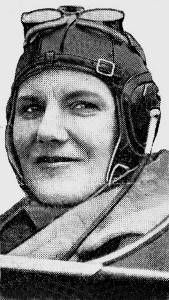
Lady Young prepares for take-off
At 08.10 on 28th February 1935,
Lady Young, wife of Sir Hubert Young, the Governor of Northern
Rhodesia, took off from Livingstone in her own Gypsy Moth to join
her husband in Lusaka where he was attending to the transfer of the
capital of Northern Rhodesia from Livingstone. Lady Young had not
fully recovered from a bout of malaria, and was accompanied by the
Senior Government Medical Officer, Dr T.R.F.Kerby. It was an
overcast morning and visibility was very poor, but Lady Young was
widely renowned as an expert pilot and there were no fears for her
safety.
The distance to be flown was 291 miles, and her ETA at Lusaka was 11.00.
Shortly before 11.00, Sir Hubert and a welcoming group of friends and officials gathered at the Lusaka aerodrome eagerly scanning the sky for a first glimpse of the litle aircraft. When there was neither sight nor sound by 11.15, those present began exchanging apprehensive glances. Soon afterwards, it was realised that something serious may have occurred, and immediate steps were taken to organise search parties. Messages were telegraphed and telephoned along her route, and within a very short while two aircraft and numerous Police and railway personnel were involved in the search. Patrols by rail-trolley and road were sent out, and a medical centre was set up at Monze, with a fully-equipped hospital train. .
A report was received that the plane had been seen near Choma at about 09.30 that morning, slightly to the west of the normal course, and another later siting to the east of the course. Other reports of sitings were received, but could not be substantiated. The search continued throughout the night, using flares and torches, but to no avail. By early next morning, 1st March, 200 men of the Northern Rhodesia Regiment together with six White officers, 200 Police and 170 railwaymen joined the operation which now had about 600 men on the ground. There were in addition many civilian volunteers. An operations base was established in Choma, under control of the Governor.
The first aircraft in the quest were a RANA Puss Moth piloted by Mr Reg Bourlay, and a WACO belonging to Mr. N.D.McGill of Livingstone As the days progressed, more aircraft joined in the search. These included a flight of six Wapitis very promptly despatched by the South African Air Force, two Leopard Moths from the Johannesburg Light Plane Club, a Puss Moth of the Katanga Aero Club in Elisabethville, an Imperial Airways Atalanta, and a Gypsy Moth piloted by a Mr Elton of Melsetter, Southern Rhodesia. A Westland Wessex and then a Leopard Moth, newest and fastest of the RANA fleet, entered at a later stage. At one time there were nineteen aircraft involved in the search, their names so evocative of that period.
The area from Livingstone to Broken Hill was carefully mapped, and thoroughly swept by very low-flying planes. Ground patrols operated throughout the day and using flares at night. The quest was concentrated largely twenty miles on either side of the railway line, as it was thought the plane could not have strayed much further off course than that. From Lusaka, special searches were made of the flooded Kafue Flats, as there was a possibility that the plane may have crashed and sunk in the marshy ground.
This became the most extensive ground and air search ever undertaken in Northern Rhodesia, and probably in the whole of Southern Africa at that time.
Unfortunately it was taking place far to the north of the site where Lady Young had crashed. Over a hundred miles to the north, in fact ..........
The distance to be flown was 291 miles, and her ETA at Lusaka was 11.00.
Shortly before 11.00, Sir Hubert and a welcoming group of friends and officials gathered at the Lusaka aerodrome eagerly scanning the sky for a first glimpse of the litle aircraft. When there was neither sight nor sound by 11.15, those present began exchanging apprehensive glances. Soon afterwards, it was realised that something serious may have occurred, and immediate steps were taken to organise search parties. Messages were telegraphed and telephoned along her route, and within a very short while two aircraft and numerous Police and railway personnel were involved in the search. Patrols by rail-trolley and road were sent out, and a medical centre was set up at Monze, with a fully-equipped hospital train. .
A report was received that the plane had been seen near Choma at about 09.30 that morning, slightly to the west of the normal course, and another later siting to the east of the course. Other reports of sitings were received, but could not be substantiated. The search continued throughout the night, using flares and torches, but to no avail. By early next morning, 1st March, 200 men of the Northern Rhodesia Regiment together with six White officers, 200 Police and 170 railwaymen joined the operation which now had about 600 men on the ground. There were in addition many civilian volunteers. An operations base was established in Choma, under control of the Governor.
The first aircraft in the quest were a RANA Puss Moth piloted by Mr Reg Bourlay, and a WACO belonging to Mr. N.D.McGill of Livingstone As the days progressed, more aircraft joined in the search. These included a flight of six Wapitis very promptly despatched by the South African Air Force, two Leopard Moths from the Johannesburg Light Plane Club, a Puss Moth of the Katanga Aero Club in Elisabethville, an Imperial Airways Atalanta, and a Gypsy Moth piloted by a Mr Elton of Melsetter, Southern Rhodesia. A Westland Wessex and then a Leopard Moth, newest and fastest of the RANA fleet, entered at a later stage. At one time there were nineteen aircraft involved in the search, their names so evocative of that period.
The area from Livingstone to Broken Hill was carefully mapped, and thoroughly swept by very low-flying planes. Ground patrols operated throughout the day and using flares at night. The quest was concentrated largely twenty miles on either side of the railway line, as it was thought the plane could not have strayed much further off course than that. From Lusaka, special searches were made of the flooded Kafue Flats, as there was a possibility that the plane may have crashed and sunk in the marshy ground.
This became the most extensive ground and air search ever undertaken in Northern Rhodesia, and probably in the whole of Southern Africa at that time.
Unfortunately it was taking place far to the north of the site where Lady Young had crashed. Over a hundred miles to the north, in fact ..........
Mr. Cameron at his trading store
After taking off from Livingstone, Lady Young encountered areas of
high turbulence. Visibility was poor, but by means of her compass,
she was able to keep her little plane on course. Some time later she
saw below a large river which she took to be the Kafue. Lusaka could
not be far away. She passed over the river, but instead of the
sprawling buildings of Lusaka, she saw what she recognised as the
Kariba Gorge. She was far off course and had petrol reserves for
only about twenty minutes flying time. It appeared that the
turbulence had loosened the locking screw of her compass, which was
now wildly inaccurate. It was imperative to find a reasonably safe
place in which to land.
In an extremely inhospitable terrain, the only possibility that offered itself was what appeared to be a patch of mealies. As they braced themselves for impact, Lady Young realised that it was in fact a patch of 14 foot high kaffircorn. The stalks entwined themselves around the undercarriage, and the plane toppled over, coming to rest on its back. Lady Young managed to scramble out of the wreck, but Dr. Kerby was trapped in his harness, covered in petrol. He managed to free himself, and to their great relief, they found each other still alive. The only injury was a cut on Lady Young’s nose. The time was about 11.40. Shortly afterwards, some Africans appeared from a nearby kraal and told them there was a white man somewhere in the area. This was Mr. G. W. Cameron, a locust ranger and trader.
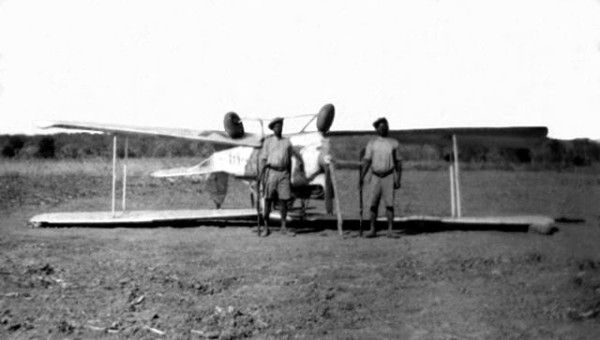
"On Guard"
In an extremely inhospitable terrain, the only possibility that offered itself was what appeared to be a patch of mealies. As they braced themselves for impact, Lady Young realised that it was in fact a patch of 14 foot high kaffircorn. The stalks entwined themselves around the undercarriage, and the plane toppled over, coming to rest on its back. Lady Young managed to scramble out of the wreck, but Dr. Kerby was trapped in his harness, covered in petrol. He managed to free himself, and to their great relief, they found each other still alive. The only injury was a cut on Lady Young’s nose. The time was about 11.40. Shortly afterwards, some Africans appeared from a nearby kraal and told them there was a white man somewhere in the area. This was Mr. G. W. Cameron, a locust ranger and trader.

"On Guard"
Lady Young wrote a note on the back of an envelope, and asked them
to take it to the white man as quickly as possible. The note read :
“Urgent. To the first white man who receives this note. Lady Young and Dr. Kerby have had a forced landing at a native village. This appears to be near the Kariba Gorge (the Southern Rhodesia side of the river). Please immediately telegraph to Sir Hubert Young at Lusaka. Lady Young and Dr. Kerby are both unhurt, but the machine is badly damaged. We are going to follow the messenger who carries this note, and shall be grateful if you will come to meet us please”.
Shortly after dusk, Mr. Cameron arrived at the village, with food, blankets, tea, a small tent and a mosquito net. He told them that he had sent their note on to the Native Commissioner at Gokwe, by runners. They spent the night at the village. The position of the crash was later estimated to be 17.3 Lat. and 28.50 Long., or 16.55 Lat. and 28.45 Long., by different flyers over the area.
It was not until 4th March that the searchers in Northern Rhodesia would learn what had happened. When the news reached them, Sir Hubert threw a party - chastely described by the Press as “sundowners” but by participants in the search, as “what a party !”
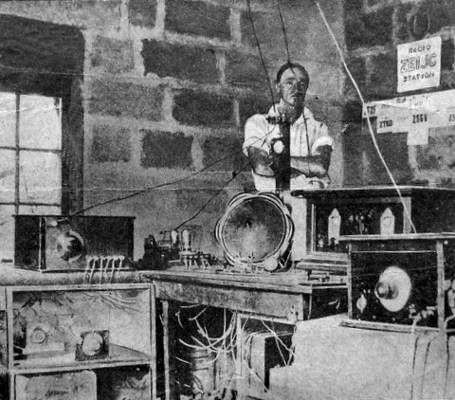
Native Commissioner Marr in his radio shack.
“Urgent. To the first white man who receives this note. Lady Young and Dr. Kerby have had a forced landing at a native village. This appears to be near the Kariba Gorge (the Southern Rhodesia side of the river). Please immediately telegraph to Sir Hubert Young at Lusaka. Lady Young and Dr. Kerby are both unhurt, but the machine is badly damaged. We are going to follow the messenger who carries this note, and shall be grateful if you will come to meet us please”.
Shortly after dusk, Mr. Cameron arrived at the village, with food, blankets, tea, a small tent and a mosquito net. He told them that he had sent their note on to the Native Commissioner at Gokwe, by runners. They spent the night at the village. The position of the crash was later estimated to be 17.3 Lat. and 28.50 Long., or 16.55 Lat. and 28.45 Long., by different flyers over the area.
It was not until 4th March that the searchers in Northern Rhodesia would learn what had happened. When the news reached them, Sir Hubert threw a party - chastely described by the Press as “sundowners” but by participants in the search, as “what a party !”

Native Commissioner Marr in his radio shack.
Soon after 5 p.m. on Monday, 4th March, a runner arrived at the Native Commissioner’s camp at Gokwe, bearing the dramatic message from Lady Young. Mr. F. Marr, the NC (callsign ZELJC), immediately set about transmitting the information by Morse Code. At 5.15 he made contact with Mr. R.A.Jubb (callsign ZEIJN), the Government Meteorological Officer in Bulawayo, and it was promptly passed on to the relevant officials in Southern and Northern Rhodesia. Daventry picked it up, and within minutes a message that had been carried by runners 90 miles on foot for four days through Southern Rhodesia’s wildest country was flashed around the whole world.
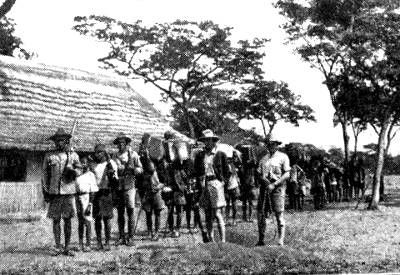
A Native Department patrol sets out.
The N.C. despatched two messengers, Zhara and Mangwiro, to ride
through the night with a message for Lady Young and bundles
containing champagne, cigarettes and food. Unfortunately by the time
they arrived 90 miles away, Lady Young and her party had already
departed by another route.
Next day, 5th March, a Westland Wessex, first aircraft to land on the recently-completed landing strip at Gokwe, was also despatched with champagne, cigarettes, sandwiches and other supplies for the stranded party. Gokwe appears to have held an inexhaustible supply of champagne in those days ! A message was included informing Lady Young that the N.C. was setting off in a car and a truck to cut a road through to Cameron’s camp, to rescue them. Mrs. Marr, wife of the N.C. (who was coping with the sudden emergency and influx of visitors in the way of all Native Department wives), had provided bed linen for the making of parachutes in which the champagne and other supplies were to be dropped to Lady Young.
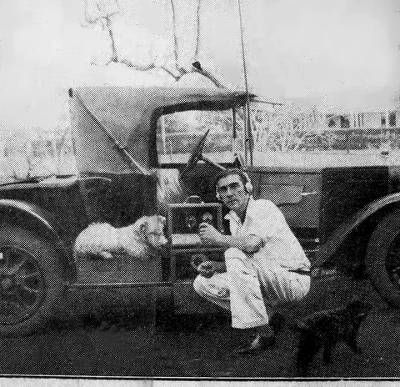
Mr. R.A. Jubb with the portable radio set used by Mr. Marr.
The pilot was unable to find Cameron’s camp in that wilderness, and so returned to Gokwe. Lady Young and her party were therefore unaware that the search was under way, and set forth on foot and machila for Gokwe. Unfortunately, this was by a different route from that which was being cut by the N.C. who had with him a portable radio set provided by the 1st Battalion of the Rhodesia Regiment. This was a low-powered set, and was unfortunately unable to receive messages later sent to inform him that it had been learned Lady Young’s party was proceeding by a different route. Mr Marr was able to make radio contact only when he had reached Cameron’s camp, by which time the missing party was approaching Gokwe. All his efforts to cut a road through to Cameron’s camp were in vain, but were very favourably commented on.
Next day, 5th March, a Westland Wessex, first aircraft to land on the recently-completed landing strip at Gokwe, was also despatched with champagne, cigarettes, sandwiches and other supplies for the stranded party. Gokwe appears to have held an inexhaustible supply of champagne in those days ! A message was included informing Lady Young that the N.C. was setting off in a car and a truck to cut a road through to Cameron’s camp, to rescue them. Mrs. Marr, wife of the N.C. (who was coping with the sudden emergency and influx of visitors in the way of all Native Department wives), had provided bed linen for the making of parachutes in which the champagne and other supplies were to be dropped to Lady Young.

Mr. R.A. Jubb with the portable radio set used by Mr. Marr.
The pilot was unable to find Cameron’s camp in that wilderness, and so returned to Gokwe. Lady Young and her party were therefore unaware that the search was under way, and set forth on foot and machila for Gokwe. Unfortunately, this was by a different route from that which was being cut by the N.C. who had with him a portable radio set provided by the 1st Battalion of the Rhodesia Regiment. This was a low-powered set, and was unfortunately unable to receive messages later sent to inform him that it had been learned Lady Young’s party was proceeding by a different route. Mr Marr was able to make radio contact only when he had reached Cameron’s camp, by which time the missing party was approaching Gokwe. All his efforts to cut a road through to Cameron’s camp were in vain, but were very favourably commented on.
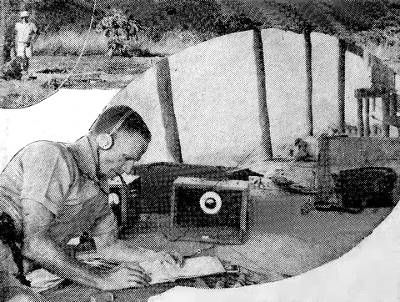
Mr. Marr transmitting at Cameron's store.
But to get back to the crash. The next morning, Friday, 1st March, Lady Young, Dr. Kerby and Mr. Cameron walked to his camp, which was about six miles from the crash. They spent the day resting there, considering their next move. Knowing how difficult their journey would be, Mr. Cameron had a machila made with branches and bark for Lady Young. They had a long way to go, and at 6.45 on 2nd March the little caravan set forth – Lady Young walking part of the way to spare the machila carriers. That day they covered about 16 miles in hot and difficult conditions, and spent the night at an African village. The next day was more difficult, and a shorter distance was covered.
Mr. Cameron arranged everything possible for the comfort of his wards. He had provided a small tent and a mosquito net for Lady Young, and they were able to bathe every day. The “bath” consisted of a hole scooped in the ground, lined with a piece of canvas, and filled with water. It was essential to keep up appearances, and the men shaved each day, Dr Kerby borrowing Mr. Cameron’s “cut-throat” razor.
On Monday 4th they made good progress, and spent the night at the village of Chief Sileya. Tuesday was very hot and the going rough. Wednesday was another good day and that night they slept in a village which they calculated was 26 miles from Gokwe. Setting off very early on the morning of Tuesday 7th March, it was not long before they heard the sound of a motor car, and near Sweswe were picked up by Capt. Bugler of the BSAP. Their long hike was over. They had walked about 70 miles.
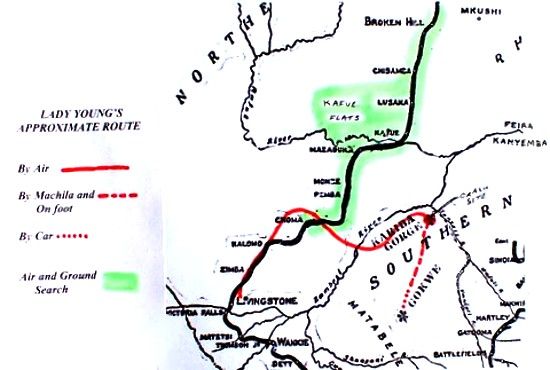
Sketch map.
They were received by Mrs. Marr at the NC’s house in Gokwe, where their first request was for a hot bath. At 4 pm they took off in the waiting Westland Wessex, arriving to an enthusiastic reception in Lusaka at 6 pm. – seven days and seven hours after their original ETA !

The Westland Wessex which took Lady Young and Dr Kerby
back to Lusaka
Once Mr. Cameron had delivered his charges safely at Gokwe, he turned and quietly set off on foot back to his camp ninety miles away.
Lewis Walter
Fish Hoek, Cape
July 2012
End
My thanks to Mrs. Dorothy Marr, daughter-in-law of Native Commissioner Frederick Marr, for documents and information concerning him, and to Mrs. Dee Dowson for getting them safely to me. Also to Dave Newnham, Mike Hamence, Ron Jarman, Nick Baalbergen, Mitch Stirling, Tony Richardson, Bill Wiggill and Sean Morgan for information and references
The wreckage of Lady Young’s plane was eventually dismantled and removed to Que Que.
She became President of the Flying Club in Lusaka, and when they held their first rally in 1937, she won the Landing Competition !
ORAFs records its thanks to Lewis and all those members that assisted him with this project.
Lady Young and Her
Gypsy Moth
Part 2 Newspaper
Cuttings and Comments
A wonderful response and feedback was enjoyed by various readers of the initial article that was written by Lewis Walter.
The cherry on the top of this feedback was when David Morton made available a array of newspaper cuttings that covered this search and rescue operation. These I have now extracted and recompiled them and are placed below. I think the newspapers involved were the Rhodesia Herald and Bulawayo Chronicle.
Dated 5 March 1935
LADY YOUNG AND DR. KERBY FOUND UNHURT
A forced landing in Southern Rhodesia
Machine Damaged 130 Miles West of Salisbury
Message Brought in by Native Runner
LADY YOUNG and Dr. Kerby have been found unhurt. They had a miraculous escape when their machine made forced landing in the Sebungwe district of Southern Rhodesia at a point about eighty miles north of Gokwe, a lonely station about 130 miles west of Salisbury.
A native messenger arrived at the camp of Mr. D. Cameron, the locust officer of the Gokwe area, bearing a
message stating that the machine in which Lady Young and Dr. Kerby were flying had been forced down and was badly damaged, but that they were unhurt. Mr. Cameron sent inmessage to Mr. F. A. Marr, the Native Commissioner at Gokwe, passing on this information, and adding that he was going at once by car to the scene of the crash, which was about forty miles from his camp.
The good news was received yesterday afternoon by Mr. Marr, who lost no time in sending it to Bulawayo by wireless, where it was passed on without delay to Sir Hubert Young at Mazabuka, which was at that moment the centre of operations in the widespread search being carried on by aeroplane in the North.
Lost Direction
It appears that shortly after leaving Livingstone last Thursday for Lusaka the machine swung to the south-east and crashed on the Southern Rhodesian side of the Zambesi. It has still to be learned how long Lady Young and Dr. Derby were marooned before being able to send in the message by the native runner.
Sir Hubert Young is leaving for Gokwe by aeroplane this morning. If Lady Young is fit to make the flight she will return with her husband to Livingstone to-day.
It was arranged last night that the Rhodesian and Nyasaland Airways Westland Wessex aeroplane should leave Salisbury at seven o'clock this morning for Gokwe, conveying the Minister of Internal Affairs (the Hon. V. A. Lewis), Major D. Cloete, the Technical Adviser and Inspector of the Civil Aviation Department, and Lieut. I. de B. C. Fynn, the Signals Officer of the 1st Battalion, The Rhodesia Regiment, who is taking with him a portable wireless set from the Drill Hall at Salisbury. The Westland Wessex will be piloted by Captain G. I. Thomson, the Operations Manager of the Rhodesian and Nyasaland and it will carry a supply of provisions.
How The News Was Received
(From Our Own Correspondent)
Bulawayo, Monday
The dramatic story of the adventure of Lady Young and Dr. Kerby was pieced together to-night by representatives of The Rhodesia Herald at Bulawayo, who made inquiries by telephone and telegraph following the receipt of the definite announcement that the occupants of the missing aeroplane had at last been discovered after having been lost for five days.
It appears that shortly after leaving Livingstone last Thursday, after Lady Young had taken off for Lusaka to rejoin her husband, who preceded her on Sunday in another aeroplane, her machine swung to the south-east and eventually crashed on the Southern Rhodesia side of the Zambesi River in a most wild and desolate part of the Colony.
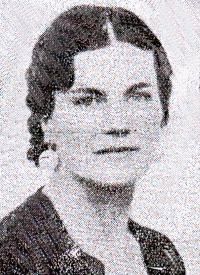
LADY YOUNG
It has still to be learned whether the occupants of the machine had difficulty in extricating themselves, and how long it was before they were able to get in touch with the means of assistance.
A Native Messenger
They were precipitated into a district where white- people seldom venture and where indeed natives are rarely seen because of the menace of tsetse fly -and unhealthy swamps. For several days Lady Young and Dr. Kerby were lost in these unpleasant surroundings. When eventually a native appeared from the bush, he was greatly surprised to find white people in this remote spot.
Lady Young, it is stated, immediately summoned the native and wrote a hurried note reporting what had happened and urging that help should be sent without delay. In this letter she said that they had crashed, that the plane had been badly damaged but that Dr. Kerby
and herself were unhurt.
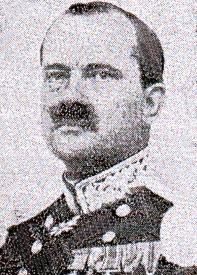
SIR HUBERT YOUNG
The native was urged to make all haste, and that he did so is proved by the fact that bearing a letter, the importance of which he probably did not fully appreciate, he arrived at the camp of Mr. D. Cameron, a local trader and locust Officer, who despatched another native to Mr. F. A. Marr, the Native Commissioner at Gokwe, many miles distant.
Wireless Message
Mr. Marr, who fortunately happened to be one of the small band of amateur wireless operators in Southern Rhodesia (there are about eight altogether) immediately sent out a Morse signal which by another happy chance was picked up by a Bulawayo amateur, who has his station at the Observatory
Contact was made and the message transmitted was to the effect that Mr. Marr (station ZELJC) had received a communication from Lady Young and Dr. Kerby intimating that they had had a forced landing. The machine was badly damaged, but both the occupants were unhurt.
The original message had first been received by a Government locust ranger, Mr. D. Cameron, whose camp was 40 miles from the spot where the plane had landed. Mr. Cameron immediately sent the message on to Gokwe, and himself set out to find Lady Young and Dr. Kerby.
As noon as the amateur operator at station ZEIJN in Bulawayo had decoded the Morse message for Gokwe he passed the information on to the C.I.D. headquarters and to the Government wireless station in Salisbury, who in turn immediately opened up and made contact with Mr. Marr at Gokwe.
Further information concerning Lady Young and Dr. Kerby was naturally sought, but unfortunately the atmospheric conditions were unfavourable. Mr. Marr's set is a small low power outfit and as atmospheric "skip" had set in with the onset of night it was found impossible to get any fresh news from Gokwe on the amateur wave band.
However, the original Morse message sent out by the Native Commissioner from Gokwe at 5.15 this evening had been confirmed about three-quarters of an hour later, when the amateur operator in Bulawayo again made contact with him, so there was no possible doubt about the accuracy of the news.
The Scene of the Crash
It was learned to-night that the forced landing occurred at latitude 17 degrees 3 minutes south, and longitude 28 degrees 50 minutes east.
On a large scale map this reading indicated a point close to the Mapongola mountains, nearly 80 miles almost due north of Gokwe. A line ruled east from Livingstone would pass well south of the spot where the plane landed. Gokwe is just over 90 miles by road from Que Que, the nearest centre of civilisation.
On the trek from the wrecked aeroplane through the locust ranger's camp and so on to Gokwe the travellers will cover about 100 miles, as the camp is west of Gokwe, and the place where the aeroplane came down is to the north.
Mr. Marr, the Native Commissioner, intends to set out by car early to-morrow morning in the direction of Mr. Cameron's camp to pick up Lady Young and Dr. Kerby.
It is a fortunate circumstance that the landing ground at Gokwe was completed only a month ago and is reported to be in excellent condition
End
THE SEARCH IN THE NORTH A STRIKING CONCENTRATION OF AEROPLANES
Captain G. I. Thomson, D.F.C., Operations Manager of the Rhodesian and Nyasaland Airways, returned to Salisbury yesterday after participating in the aeroplane search for Lady Young in Northern Rhodesia. interviewed by a representative of The Rhodesia Herald he said that no effort of organisation had been spared to render the search effective, and provision had been made at the various landing grounds for quick refuelling of the machines engaged in the search. The pilots and observers were spending nearly all their time in the air, snatching hasty meals while their planes were tilled up, and securing what little rest they could. The personnel of the search were being billeted in private houses near the aerodromes.
There were five South African Air Force Wapiti planes engaged in the search, three R.A.N.A. machines and two Leopard Moths of the Johannesburg Light Plane Club. A Waco machine belonging to and owned by Mr. Gill, of Livingstone, a Puss Moth from Elisabethvllle belonging to the Aero Club at Katanga. and the well-known private owner. Mr. Elton, of Melsetter, in his Gypsey Moth, were also participating
ATTEMPTING TO REACH LADY YOUMG
ROAD PARTY LEAVES GOKWE FOR LONELY STOIRE
AEROPLANE'S UNSUCCESSFUL SEARCH
VISIT OF MINISTER OF INTERNAL AFFAIRS
(Dated March 6, 1935)
No further communication has been received from Lady Young and Dr. Kerby, and a party in motor-cars set off yesterday from Gokwe for the lonely trading store of Mr. G. W. Cameron, who received the original message announcing the safety of the missing flyers, to bring them into Gokwe.
The Westland Wessex passenger aeroplane belonging to the Rhodesian and Nyasaland Airways is being held in readiness at Salisbury aerodrome, and immediately the news is received from Gokwe that Lady Young has arrived there, the machine will be sent off to convey her to Lusaka.
Yesterday this machine flew to Gokwe and an attempt was made to reach Mr. Cameron's store from the air so that a message and provisions could be dropped for Lady Young. Despite a careful search, however, the store could not be located.
It was revealed yesterday that shortly before Lady Young's machine was forced down the Minister of Mines
(the Hon. W. S. Senior) was flying near the spot. Had Mr. Senior been a couple of hours later he might have sighted the damaged plane.
THE COINCIDENCE OF A MINISTER'S FLIGHT
The Rhodesian .and Nyasaland Airways' three engine Westland Wessex aeroplane left Salisbury shortly after seven o'clock yesterday morning for Gokwe. It carried as passengers the Minister of Internal Affairs (the Hon. V. A. Lewis), Major D. Cloete, the Technical Adviser and Inspector of the Civil Aviation Department, and Lieut. I. de B. C. Fynn, the Signals Officer of the 1st Battalion, The Rhodesia Regiment, who took with him a portable wireless transmitting set from the Drill Hall at Salisbury. The machine was piloted by Capt. G. I. Thomson, the Operations Manager of the Rhodesian and Nyasaland Airways.
From the Air
After a pleasant flight the party reached Gokwe, and landed shortly before nine o'clock. The Minister quickly made himself acquainted with the situation, and when Mr. F. A. Marr, the Native Commissioner at Gokwe, had explained how difficult it would be to get in touch with Mr. G. W. Cameron's lonely store by car, it was decided to make a reconnaissance by air, and try to drop a message to Lady Young together with some provisions. A parachute was improvised from a bed sheet and a parcel of foodstuffs was made up. Mr. Lewis wrote a note to Lady Young explaining the presence of the aeroplane, and suggesting that, as an attempt was being made to reach her by car, valuable time would be saved if she were to travel part of the way with native guides to meet the road expedition.
Unsuccessful
Unfortunately the party in the aeroplane were unable to locate Mr. Cameron's store from the air. They reached the point on the map that had been given them as the location of the store, but they could see no sign of any building or any human activity remotely suggesting a trading centre. The aeroplane searched the locality in wide sweeping circles but without success. The country is covered with thick bush and high grass, and it was possible here and there on the way to discern the rough track leading in the direction of Mr. Cameron's store, but the store itself could not be seen. The necessity to conserve the petrol supply had then to be considered, and it was ultimately reluctantly decided to return to Gokwe with the note, for Lady Young undelivered. The plane had been away from Gokwe
for an hour and a half.
Relief Party
On their return it was decided that Mr. Marr with a car and a lorry accompanied by the representative of The Rhodesia Herald and the "Bulawayo Chronicle" should set off for Mr. Cameron's store, but as a precaution it was deemed advisable to send a small advance party of native messengers. Two native constables at the police post readily volunteered to make the trip by bicycle. They were given arms in case they should be over- taken by darkness, and they were promised a reward by Mr. Lewis if they succeeded in reaching Lady Young last flight. Small bundle containing among other things sandwiches and some champagne were given the natives together with a note for Lady Young suggesting she should employ the constablesstables as guides and travel by machila to meet the cars that were coming to bring her in to Gokwe.
The Start
Shortly after midday Mr. Marr's expedition started, the lorry conveying a gang of natives who were taken as a precaution against the party being unduly delayed by the bad state of the road. The natives were also to make rough and ready repairs at impassable points to facilitate the return. As wide sandy rivers will have to be crossed, lengths of wire netting were taken to help the cars to negotiate such difficulties.
It was decided to leave Lieut. Fynn at Gokwe in charge of the wireless station, and the Westland Wessex started on the return jourey to Salisbury with Mr. Lewis and Major Cloete at 3.45. But the excursion over the bush in search Mr. Cameron's store had used up a good deal of the petrol, and
It was found necessary to break the journey at Gatooma to re-fuel.
The machine reached Salisbury at six o'clock
Arrangements
Arrangements have been made to send the Westland Wessex back to Gokwe immediately the news is received by wireless from Lieut. Fynn that. Lady Young has arrived there.
The machine will carry with it a hamper of clothing and comforts for Lady Young from Lady Stanley.
It is hoped that, with luck, Lady Young will reach Gokwe to-day. She will be conveyed with the least possible delay to Lusaka by the Westland Wessex.
End
THE MESSAGE WITH THE GOOD NEWS
RELIEF EXPEDITION FROM GOKWE
The following message was reieved yesterday by wireless from the special correspondent of The Rhodesia Herald and the "Bulawayo Chronicle" who travelled to Gokwe by car from Bulawayo on Monday night:—
"Urgent. To the first white man who receives this note."
This was the startling address on the note received by Mr. G. W. Cameron, the trader and locust ranger, from a native in the wild, inhabited country on the Southern. Rhodesian side of the Zambesi.
The note was written on an envelope and read:—
Lady Young and Dr. Kerby have a forced landing at a native village. This appears to be near Kariba Gorge (the Southern Rhodesian side of the river). Please immediately telegraph to Sir Hubert Young at Lusaka. Lady Young and Dr. Kerby are both unhurt, but the machine is badly damaged. We are going to follow the messenger who carries this note and should be grateful if you will come to us please.
The note reached Mr. Cameron and was passed from hand to hand by natives to Gokwe with a following note from :-
I am accompanying the expedition led by Mr. F. A. Marr, the Native Commissioner at Gokwe, which is leaving to-day to bring Lady Young into Gokwe
End
NEWS OF LADY YOUNG
(Dated: 7-3-35)
REACHING GOKWE TODAY
THEN FLYING DIRECT TO LUSAKA
MESSAGE FROM KING AND QUEEN
LADY YOUNG and Dr. Kerby are expected to reach Gokwe to-day. They will be conveyed direct to Lusaka in an aeroplane which was flown to Gokwe from Salisbury yesterday.
Sir Hubert Young, the Governor of Northern Rhodesia, yesterday received a message from the King and Queen, expressing Their Majesties' relief on hearing that Lady Young had been found unhurt.
End
PLANE IN READINESS AT GOKWE
A message was received in Salisbury last night by wireless from Gokwe announcing that Mr. G. W. Cameron had sent in a native messenger with the information that he was bringing Lady Young and Dr. Kerby in to Gokwe. Mr. Cameron is the trader and locust ranger who received the original message brought in by native runner from Lady Young and Dr. Kerby, and who went out to find them.
Mr. Cameron's note, which reached Gokwe at about six o'clock last evening, stated that he expected to reach the Swiswi River, about twenty miles from Gokwe this morning.
Capt. Bugler, of the British South Africa Police, left Gokwe by car at eight o'clock last night to meet the party and assist them in to Gokwe to-day.
When Lady Young and Dr. Kerby reach Gokwe they will come under the care of Capt. G. I. Thomson, the Operations Manager of the Rhodesia and Nyasaland Airways, who flew to Gokwe yesterday from Salisbury in the company's three engine Westland Wessex machine.
They will be flown direct to Lusaka in the Westland Wessex.
LADY YOUNG'S PLANE SEEN ON RETURN FLIGHT TO LUSAKA.
When the Rhodesian and Nyasaland Airways Westland Wessex aeroplane, which was flying Lady Young and Dr. Kerby from Gokwe to Lusaka on Thursday afternoon, passed over the spot where Lady Young made her forced landing, the damaged aeroplane was clearly visible from the air.
Capt. G. I. Thomson, who was piloting the Westland Wessex, brought his machine down until he was flying at about 100 feet above the ground. Lady Young's plane was seen to be upside down, but it was impossible to discern from the air the extent to which it had been damaged.
"The exact spot was very difficult to find from the air," Capt. Thomson told a representative of The Rhodesia Herald on his return to Salisbury yesterday. "It is only a tiny clearing in the dense bush, and it was the only spot within a radius of twenty miles on which Lady Young could have landed with any degree of safety. Considering the size of the patch, she must have made a very good landing indeed. The stalks of the kaffir corn turning the machine over was a piece of rank bad luck.
"The machine was lying in the clearing and it was difficult to see it until we were right on top of it.'"
Capt. Thomson estimates the position of the damaged plane to be: latitude, 16 degrees 55 mins. south; longitude, 28 degrees 45 mins. east.
End
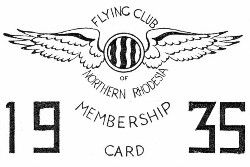

LADY YOUNG SAFELY BACK IN LUSAKA
(Dated: 8-3-35)
TRYING EXPERIENCE DUE TO COMPASS TROUBLE
FORCED TO LAND THROUGH PETROL SHORTAGE
70-MILE TREK THROUGH THE BUSH BY MACHILA
LADY YOUNG and Dr. Kerby arrived safely in Gokwe yesterday and later in the afternoon they were flown to Lusaka, thus bringing to an end a trying experience that is likely to befall few aerial travellers in Southern Africa.
Apparently Lady Young's aeroplane lost direction through a compass defect which developed owing to the "bumpy" flying conditions experienced after the machine left Livingstone. Lady Young realised after a time not only that she was on the wrong side of the Zambesi but that the petrol supply was almost exhausted. She landed the machine in a native field, and although the aeroplane overturned, neither she nor Dr. Kerby was hurt.
From a native village near the spot where their machine landed Lady Young and Dr. Kerby were guided into Gokwe, a distance of nearly 90 miles, by Mr. G. W. Cameron, the locust ranger. Dr. Kerby made the journey on foot, but Lady Young was transported in a primitive machila made of bark and poles. Only the last 20 miles of the journey they covered in a car, which had come to meet them.
End
TRIBUTE TO MR. CAMERON
(From Our Own Correspondent)
Bulawayo, Thursday.
On Thursday, February 28, Lady Young, the wife of His Excellency Sir Hubert Young, K.C.M.G., the Governor of Northern Rhodesia, piloting her own machine left Livingstone to join her husband at Lusaka, accompanied by Dr. T. R. F. Kerby, one of the senior Government medical officers in the territory. As the result of a mishap to the compass due to the "bumpy" weather experienced, Lady Young found herself flying over strange country and suddenly realised that instead of crossing the Kafue River on the northward flight she had actually drifted into Southern Rhodesia and was above the Kariba Gorge with its densely-wooded sides and rough terrain.
Added to this was the sudden discovery that the petrol supply was rapidly running short. Indeed 20 minutes later would see the plane out of action.
Machine Overturned
With the resource that-her training in aviation had given her, Lady Young quickly decided that the only thing to do was to descend. But in this part of the Colony the difficulty was to pick a suitable spot. What appeared to be a mealie patch proved on approaching it to be a field of Kaffir corn, and into this 14ft. tangle the aeroplane dropped.
The machine was immediately in difficulties. It hit the ground with some force, the cornstalks entwined themselves in the undercarriage, and the plane slowly toppled over. It was a terrible moment for Lady Young and Dr. Kerby, and each thought the other killed and great was their relief when they met from opposite sides of a wrecked machine.
"A Little Tired"
Shortly before four o'clock this afternoon Lady Young and Dr. Kerby were in the Salisbury Westland Wessex machine heading for Lusaka, passing over the scene of their memorable experiences. Lusaka was reached shortly after six o'clock, where Sir Hubert Young was awaiting his wife's arrival.
To the surprise of all who met her, including Mrs. F. A. Marr, the wife of the Native Commissioner, who acted as hostess, Lady Young arrived at Gokwe fresh and smiling, although confessing that she was "a little tired."
Lady Young's Story
The story which the representative of The Rhodesia Herald and the "Bulawayo Chronicle" who had flown to Gokwe from Bulawayo today. gathered from Lady Young was as follows:—
"Dr. Kerby and l left Livingstone at 8.10 on Thursday morning, (flying on a direct compass course for Lusaka, where I was going to join my husband. I passed Tara exactly on the course, and naturally continued with the same compass reading.
"Then we experienced 'bumpy' weather. This evidently loosened the locking screw of the compass- which I failed to notice, and I went on keeping the needle in what should have been the proper position. In actual fact I was slowly turning completely off the course though I was quite unaware of it.
Visibility Bad
"The sun was directly overhead, most of the time obscured by. thick cloud, and visibility was very bad indeed. Later we crossed the Zambesi River near the Kariba later we crossed the Zambesi River near the Kariba Gorge though I mistook this for the Kafue River
the Kafue River with its mountainous background. The Zambesi at this point is not very broad, and the Kafue in flood might look similar to it.
"We had come a long way by this time, nearly 250 miles, and as we should have been nearing Lusaka we realised that we must be well off our course. Petrol was beginning to get short—there was only a sufficient supply for another 20 minutes or so—and I circled round, looking for somewhere to land.
The Landing
"After a while we came across an open space—the first that we had seen—and I decided that it was advisable to make a forced landing rather than wait until the petrol supply ran out entirely. From the air the open space looked like a garden, but when the machine got nearer the ground I discovered that it was Kaffir corn, tall and tough.
"I made as slow a landing as I could, but the corn entwined itself around the undercarriage of the aeroplane, and we slowly turned over. Both of us escaped with cuts and bruises.
"
Shortly afterwards," continued Lady Young, "some natives from a nearby village appeared. They gave us to understand that there was a white man somewhere in the district, and we sent off a boy with a note.
Mr. Cameron Appears
"Fortunately for us Mr. G. W. Cameron, a locust ranger, was only six miles away, though he had seen no signs of our machine, and he walked into our village just as dark was falling and produced hot tea and food and blankets, next day leading us by direct bush paths in the direction of Gokwe— a total distance of some 90 miles on foot, though only some 70 miles as the crow flies.
"Dr. Kerby walked, and for the most part I was transported in a primitive machila, or bush chair made by the natives under the supervision of Mr. Cameron out of wood and bark.
"This morning we were met by Captain H. Bugler in his car at Sweswe some 20 miles from Gokwe and it was only then that we learned that the messages that we had sent by native runners had got through.
"The relief was enormous."
Tribute to Mr. Cameron
Lady Young paid a tribute to the kindness and consideration of Mr. Cameron, who led them through dense bush and high grass, providing food and seeing to whatever comforts were possible in such a wild area, and then, once they were in the car sent out to fetch them, immediately made his way back to his camp near the Sanyati River to resume his duties.
At Gokwe
When the. party arrived at Gokwe they were met by Mrs. F. A. Marr, wife of the Native Commissioner. Mr. G. H. H. Burne, Mr. Marr's assistant, also welcomed the travellers. The first thing they called for was a bath.
Lady Young and Dr. Kerby were both looking remarkably fresh after their long trek. Except for a scar on her nose. Lady Young looked a picture of health.
After lunch the party chatted for a few minutes and then drove to the aerodrome. There they boarded the Rhodesian and Nyasaland Airways Westland Wessex machine from Salisbury, and, piloted by Captain G. I. Thomson, the Operations Manager of the Company, made the flight to Lusaka, where they were welcomed by Sir Hubert Young.
End
(The Bulawayo Chronicle, Tuesday, March 12, 1935
Radio and Aeroplane to the Rescue of Lady Young.
In Photographs by the Bulawayo Chronicle's Special Representative
RELIEF PART Y LEAVING FOR THE AERODROME AT GOKWE.

Immediately on receipt of the news that Lady Young and Dr. Kerby were making for Gokwe a lorry taking provisions in a bag which, it was intended, should be dropped from the air for their relief. The Minister of Internal Affairs, the Hon. V. A. Lewis (left), went with the lorry. Major D. Cloete, technical adviser and inspector to the Civil Aviation Department, is shown holding the bag containing food, champagne, brandy, aspirin and quinine.
On this page (taken by The Chronicle's special representative, the search) illustrate the part played less enthusiasts and aeroplanes in rescue of Lady Young, wife of the Northern Rhodesia, and Dr. Kerby, who, in Lady Young's plane from Livingstone last week, made a forced landing shortage in the desolate Sebungwe, Southern Rhodesia just south of the Zambesi River.
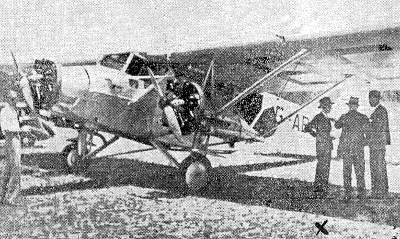
The Rhodesian and Nyasaland Airways' Westland Wessex machine, photographed at Gokwe on the day after the news was received that Lady Young and Dr. Kerby had landed in Southern Rhodesia and were safe. In the group on the right of the picture are (left to right) Captain G. I. Thomson, Operations Manager 0f R.A..N. A., the Minister of Internal Affairs (the Hon. V. A. Lewis) and Major D. Cloete, Technical Adviser and Inspector of the Civil Aviation Department.
End of newspaper cuttings.
Comment
Being an ex Northern Rhodesian I read your article with great interest although it happened before I was born. I did happen to notice however, that the map of Lady Youngs progress had a slight flaw. The map shows that Pemba was between Choma and Monze when in fact it was between Choma and Kalomo. . I was born in Luanshya in 1939 and brought up on a farm near Batoka, going to school at the Beit School in Choma.
Kind regards
Hilary Bartlett
LOG BOOK RECORDS
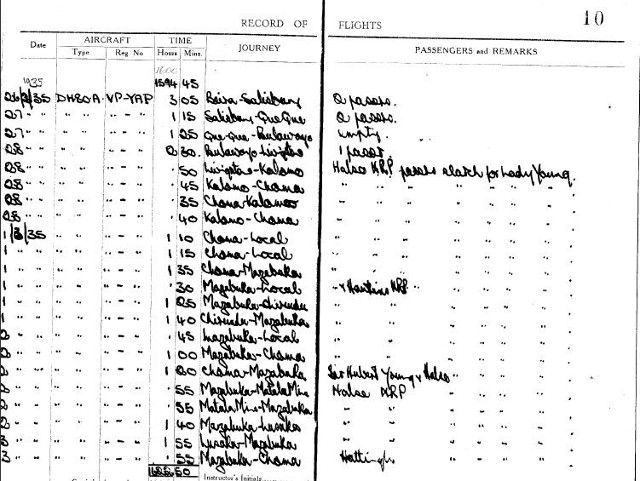
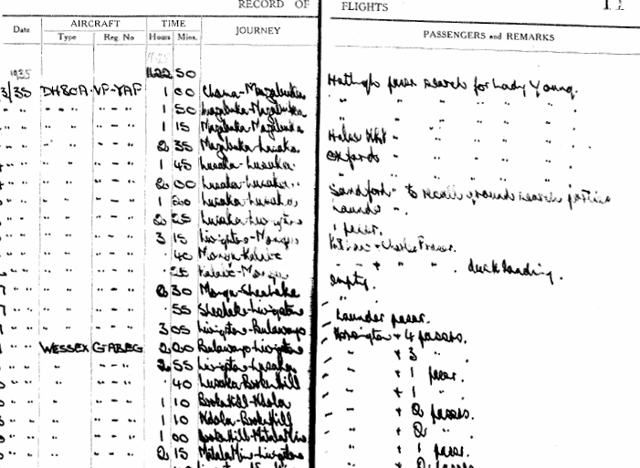
Search for Lady Young
Log book No 2
Date Type Reg. No Hours Mins Journey Passenger/Remarks
Acknowledgment Reg Bourlay for the extract out of the flight logbooks .
Page 10
28.2.35 DH80a VP-YAP 50 Livingstone/Kalomo Halse - search for Lady Young
28.2.35 DH80a VP-YAP 45 Kalomo/Choma Halse - search for Lady Young
28.2.35 DH80a VP-YAP 35 Choma/Kalomo Halse - search for Lady Young
28.2.35 DH80a VP-YAP 40 Kalomo/Choma Halse - search for Lady Young
1.3.35 DH80a VP-YAP 1 10 Choma/Local Halse - search for Lady Young
1.3.35 DH80a VP-YAP 1 15 Choma/Local Halse - search for Lady Young
1.3.35 DH80a VP-YAP 1 35 Choma/ Mazabuka Halse - search for Lady Young
1.3.35 DH80a VP-YAP 30 Mazabuka/Local Halse & Haskins NRP- search for Lady Young
1.3.35 DH80a VP-YAP 1 25 Mazabuka/Chirundu Halse & Haskins NRP- search for Lady Young
1.3.35 DH80a VP-YAP 1 40 Chirundu/Mazabuka Halse & Haskins NRP- search for Lady Young
2.2.35 DH80a VP-YAP 45 Mazabuka/Local Halse & Haskins NRP- search for Lady Young
2.2.35 DH80a VP-YAP 1 0 Mazabuka/Choma Halse & Haskins NRP- search for Lady Young
2.2.35 DH80a VP-YAP 1 20 Choma/Mazabuka Sir Hubert Young & Halse
2.2.35 DH80a VP-YAP 55 Mazabuka/ Matala Mine Halse NRP - search for Lady Young
2.2.35 DH80a VP-YAP 55 Matala Mine/Mazabuka Halse NRP - search for Lady Young
2.2.35 DH80a VP-YAP 1 40 Mazabuka/Lusaka Halse NRP - search for Lady Young
3.3.35 DH80a VP-YAP 1 40 Lusaka/Mazabuka Halse NRP - search for Lady Young
3.3.35 DH80a VP-YAP 1 0 Mazabuka/Choma Hattingh - search for Lady Young
Page 11
3.3.35 DH80a VP-YAP 1 0 Choma/Mazabuka Hattingh passenger - search for Lady Young
3.3.35 DH80a VP-YAP 1 50 Mazabuka/Mazabuka Hattingh passenger - search for Lady Young
4.3.35 DH80a VP-YAP 1 15 Mazabuka/Mazabuka Hattingh passenger - search for Lady Young
4.3.35 DH80a VP-YAP 2 35 Mazabuka/Lusaka Halse NRP- search for Lady Young
4.3.35 DH80a VP-YAP 1 45 Lusaka/Lusaka Oxford - search for Lady Young
4.3.35 DH80a VP-YAP 2 0 Lusaka/Lusaka Oxford - search for Lady Young
4.3.35 DH80a VP-YAP 1120 Lusaka/Lusaka Sandford - to recall ground search parties
Also please remember that comments are always very welcome. Send
them to orafs11@gmail,com
To view this article on line please visit
Thank you to all that assisted with this article - it is a Rhodesian epic.
Kind Regards
Eddy Norris
Irene, RSA
orafs11@gmail.com
To view this article on line please visit
Thank you to all that assisted with this article - it is a Rhodesian epic.
Kind Regards
Eddy Norris
Irene, RSA
orafs11@gmail.com
*************************
Further information received regarding this article.
Lectern
Recalls
Flying
Adventure
Sir Hubert Winthrop Young was Governor of Northern Rhodesia from 1934 to 1938. Both he and his wife were keen amateur flyers, and it was this passion for flying that led to one of Central Africa's most famous flying adventures.
On February 28, 1935, Lady Young, took off from Livingstone to Lusaka with Dr. T. R. Kerby as passenger.
The plane failed to arrive at Lusaka on schedule—11.15 a.m.—and at noon, two aircraft at Livingstone took off to search the route.
That day and for the following few days the search was continued. There was no sign of the machine until the evening of March 4, when it was reported that it had force-landed near Gokwe in Southern Rhodesia.
By this time the search by air and land was aided by the South African and Southern Rhodesian Governments, flying clubs, aircraft operating companies, private pilots, the Rhodesia Railways, newspaper reporters and many others.
Lady Young and Dr. Kerby were uninjured. The aircraft's compass had apparently failed, and crossing what they believed to be the Kafue River they were alarmed at not seeing Lusaka. They had in fact crossed the Zambesi—and there the trouble began.
In thankfulness at Lady Young's safe return, Sir Hubert commissioned the famous sculptor and type designer, Eric Gill, to carve an eagle lectern for the parish church of Lusaka, which had only that year become the capital of Northern Rhodesia.
Possibly the only example of Gill's work to be found in Africa, the lectern is carved in Hoptonwood stone, with an inscription carved in lettering of Gill's own design, from Psalm 139, vs. 9,10: "If I take the wings of the morning . . . even there shall thy hand lead me."
The lectern was blessed and used for the first time on September 1, 1940.
End
Recompiled from book 'Know your Rhodesia and Know Nyasaland', published in 1956. and made available to ORAFs by André du Plessis. Thanks Andreé
Comments are always welcome - send them to Eddy Norris at orafs11@gmail.com
Tag. Rhodesian aviation
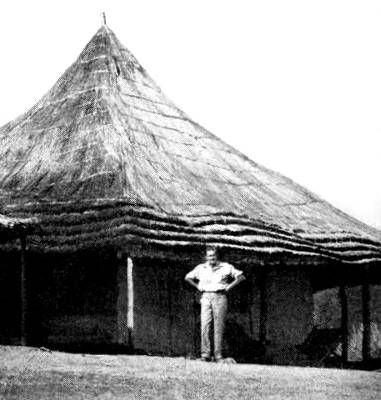



3 Comments:
Thank you for such a wonderful article. I thoroughly enjoyed reading it.
Ishbel Mulvey
Thanx Eddie - great story. Lady Young's Gypsy Moth was registered not ZS or VP but H5648; I wonder why ? I have a photo of her plane on the airstrip in Livingstone just before the engine was started in preparation for the epic Feb 1935 journey. I am tempted to slot it into the article "Early Days of Flying to Barotseland" I have written for AEROLETTERS # 106.
kind rgds
David Whitehead (whitehead@new.co.za)
an interesting account of the dangers of flying in this region at a time not so long after the first aircraft passed through the area in 1920.
Thank you.
Post a Comment
Subscribe to Post Comments [Atom]
<< Home